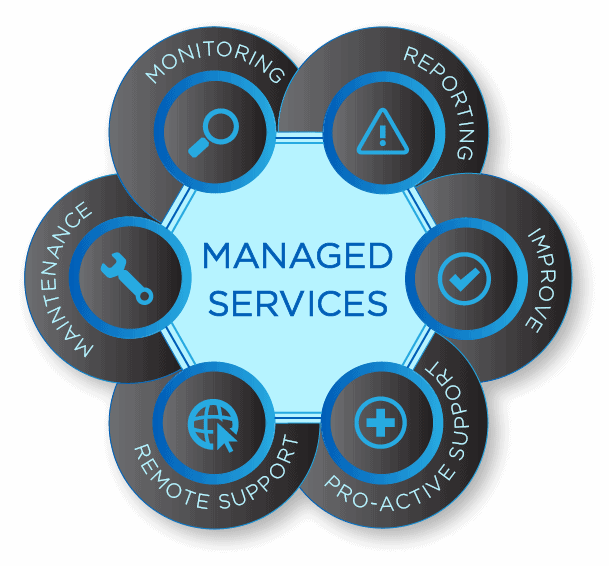Managed IT Solutions for Little and Big Organizations
Why Every Company Should Think About Managed IT Providers to Make Certain Constant System Surveillance and Maintenance
In today's quickly evolving technological landscape, services encounter raising stress to preserve durable IT facilities - Managed IT. The choice to take on handled IT solutions increases crucial considerations pertaining to cost, scalability, and the option of an ideal provider that can line up with specific service needs.
Comprehending Managed IT Services
In today's technology-driven landscape, comprehending managed IT solutions is important for companies seeking to enhance their IT infrastructure. Managed IT solutions describe the technique of contracting out particular IT works to a third-party company, called a Managed Solution Carrier (MSP) This version makes it possible for organizations to concentrate on their core competencies while making sure that their IT systems are maintained and monitored effectively.
Usually, managed IT services incorporate a vast array of offerings, including network administration, data back-up and recuperation, cybersecurity, and aid desk support. By partnering with an MSP, organizations can take advantage of customized competence and accessibility to innovative innovations without the expenses costs related to preserving an internal IT division.

Advantages of Continual Monitoring
Continuous surveillance provides numerous benefits for organizations making use of managed IT services, considerably enhancing their safety and security position and functional effectiveness. By maintaining real-time oversight of IT systems, organizations can quickly discover and react to possible hazards, decreasing the danger of information violations and cyberattacks. This positive method to safety and security not only safeguards sensitive details but likewise aids to maintain compliance with sector regulations.
Furthermore, constant tracking aids in determining efficiency bottlenecks and system susceptabilities, permitting for prompt treatments that protect against downtime and service interruptions. This ensures that IT infrastructure remains dependable and efficient in supporting business procedures effortlessly. Managed Cybersecurity. As companies significantly rely upon technology, the capacity to check system efficiency in real-time comes to be essential for maintaining performance
In addition, continual surveillance enables companies to optimize resource appropriation by giving insights right into use patterns and system health and wellness. This data-driven strategy allows for educated decision-making pertaining to upgrades and financial investments in IT facilities. Eventually, the benefits of continual tracking extend past instant safety enhancements, positioning companies for long-term success by fostering a resilient and reliable functional environment.
Proactive Upkeep Methods
Consistently implementing aggressive upkeep approaches is essential for companies making use of handled IT solutions to ensure optimal performance and reduce the danger of unanticipated failures. These methods entail methodical strategies that concentrate on identifying and dealing with possible concerns before they intensify into substantial troubles.
One key approach is normal system updates and patch administration, which assist safeguard against vulnerabilities that might be exploited by cyber risks (Managed IT services). Making sure that software application and hardware components are up-to-date not just enhances safety however also improves general system performance
Additionally, routine efficiency analyses can identify traffic jams and ineffectiveness. By assessing system performance metrics, IT teams can make enlightened decisions about necessary upgrades or source reallocations. In addition, establishing a normal timetable for information backups is important to guarding crucial information and making certain service connection.
Educating staff in finest methods for technology use is one more proactive action that reduces human mistake, which is typically a significant factor in system downtime. Ultimately, taking on a positive upkeep society cultivates a resilient IT environment that supports organization purposes and improves overall efficiency. Via these techniques, organizations can effectively alleviate threats and ensure a durable IT framework.
Cost-Effectiveness of Managed Solutions
Proactive maintenance strategies not only improve system reliability however likewise add to the total cost-effectiveness of handled IT remedies. By implementing routine monitoring and maintenance, companies can identify possible issues before they escalate, therefore decreasing the chance of costly downtime and emergency situation repairs. This preventative technique makes it possible for companies to allot their funds more effectively, as they can avoid unanticipated costs related to system failings.
Furthermore, managed IT solutions commonly use foreseeable rates models, enabling services to spending plan efficiently. Managed Cybersecurity. Unlike conventional IT setups, where expenses can change significantly because of unforeseen difficulties, managed options offer a clear understanding of continuous expenses. This openness help in financial planning, making sure that companies can buy other essential areas of their operations
Additionally, outsourcing IT management to a specialized carrier can result in considerable financial savings in labor prices and training expenses. Companies no much longer need to hire and preserve a full internal IT team, which decreases expenses. Ultimately, the assimilation of managed IT services promotes a more lasting financial design for services, allowing them to focus on development while ensuring their innovation framework remains durable and reliable.

Selecting the Right Carrier
When assessing managed IT services, choosing the ideal carrier is important for maximizing the benefits of your investment. A well-chosen carrier not just boosts your operational efficiency however likewise straightens with your service objectives and requirements. Begin by reviewing their experience and experience in your certain industry; companies with a deep understanding of your industry will be much better furnished to deal with distinct challenges.
Next, consider their variety of solutions. A thorough supplier ought to use positive monitoring, upkeep, and support, ensuring alternative protection of your IT infrastructure. In addition, scalability is important; as your organization grows, your IT requires will evolve, and your carrier needs to have the ability to adapt as necessary.

Lastly, openness in rates and services is necessary. A respectable service provider will plainly detail their offerings and costs, allowing you to make informed choices without hidden fees. By meticulously considering these factors, your company can secure a managed IT click here for info provider that promotes development and innovation.
Final Thought
In conclusion, the execution of managed IT solutions arises as a strategic need for businesses aiming to boost operational performance. Ultimately, picking the appropriate handled IT supplier is crucial for fostering a resistant IT infrastructure qualified of supporting continual growth.